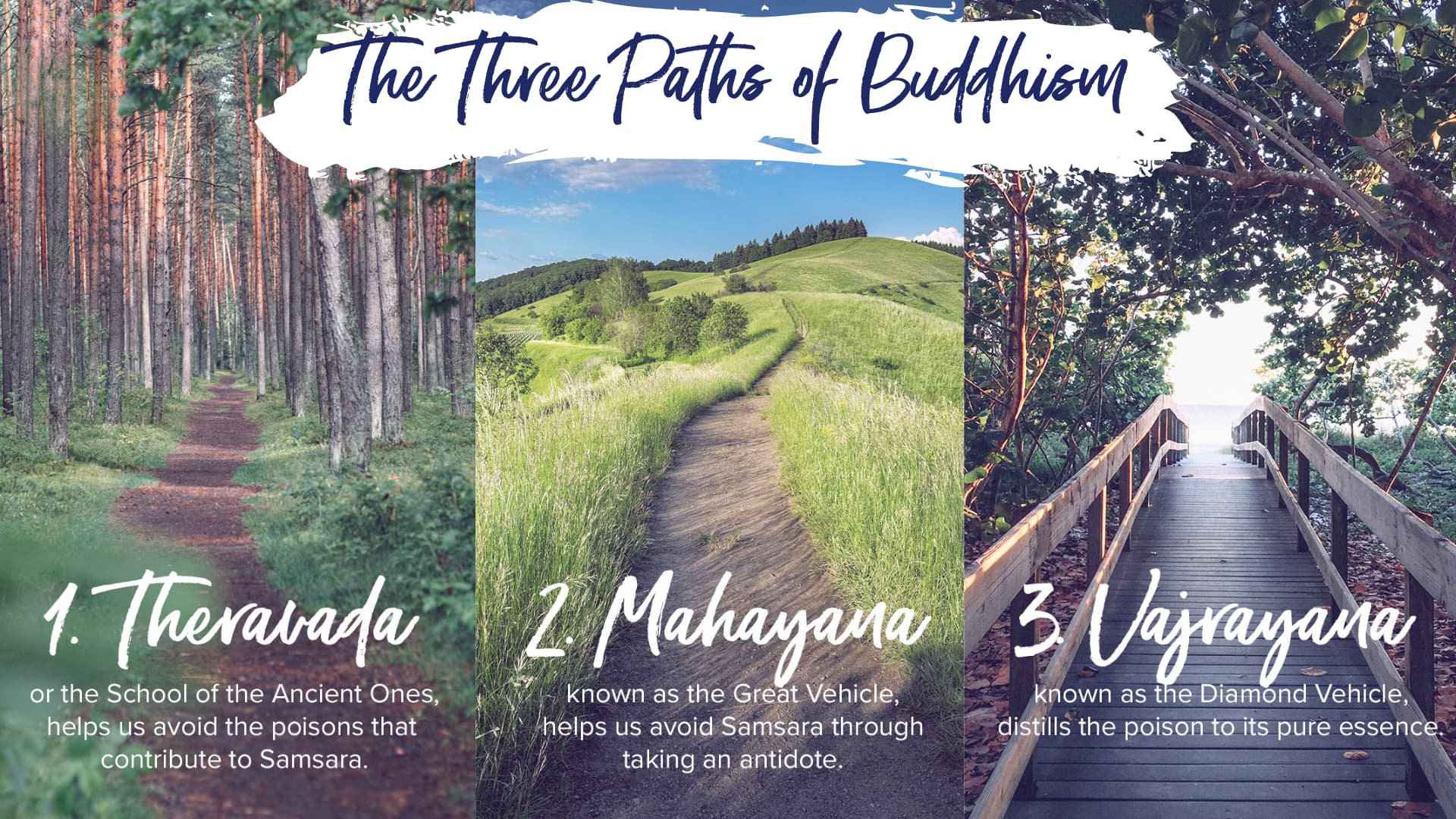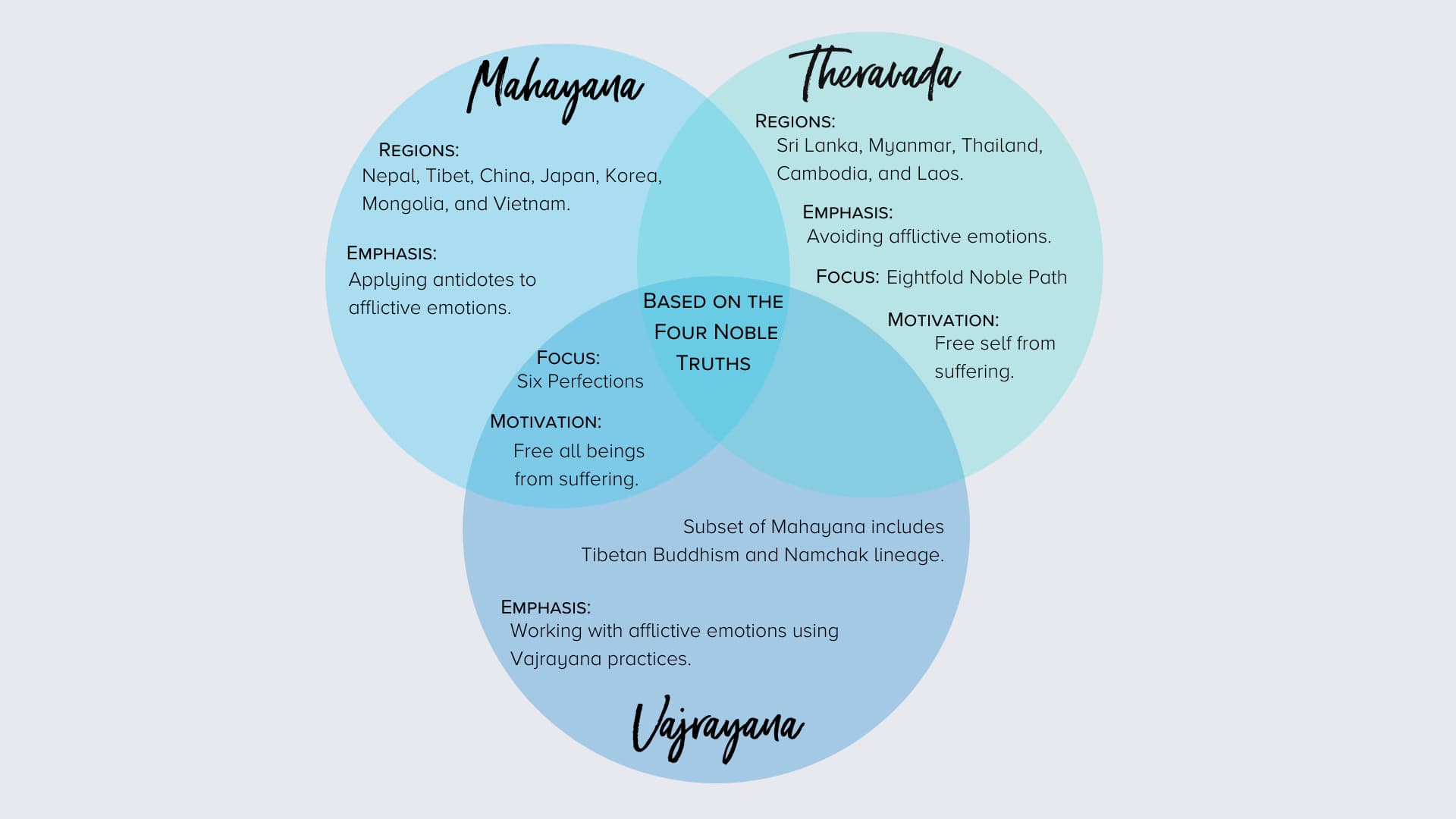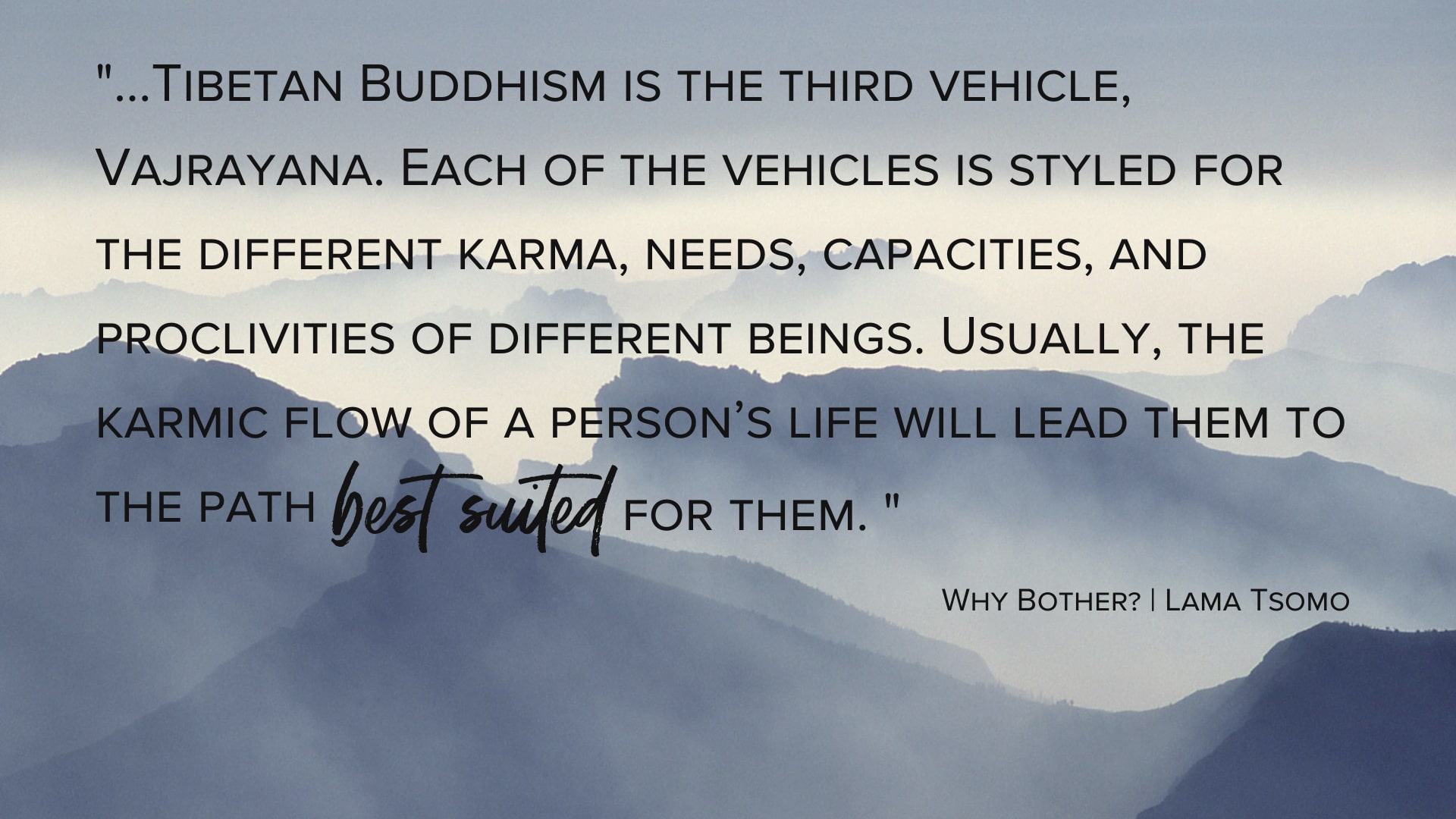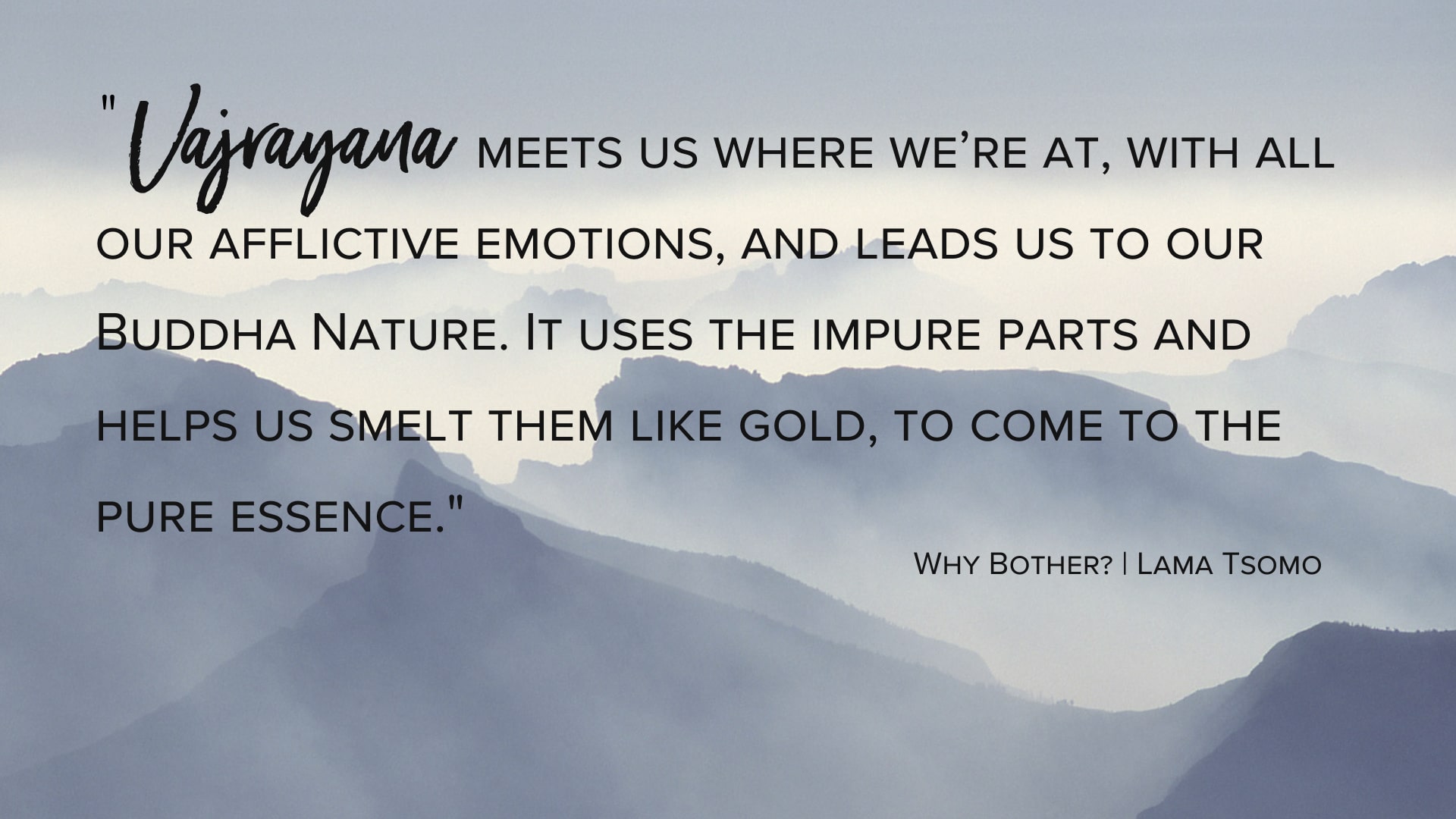
What’s the difference between Mahayana, Theravada, and Vajrayana?
Mahayana
Region: Mostly spread to Nepal, Tibet, China, Japan, Korea, Mongolia, and Vietnam.
Emphasis: Applying antidotes to afflictive emotions or poisons.
Focus: Six Perfections
Motivation: Motivation is to free all beings from suffering. Bodhicitta or the mind of enlightenment is the primary cause of enlightenment in the Mahayana. It is the wish to attain enlightenment in order to free all beings from suffering. So, no matter what practices you may engage in, if you do them with the motivation of bodhicitta, you are practicing a Mahayana path.
The Mahayana tradition accepts the validity of all the Theravada teachings such as the Eightfold Noble Path but considers that those teachings were taught to a certain group of disciples in a certain place and time. At other times, the Buddha taught the Mahayana path with its own particular aspects and emphasis which are the ones which they take as being of primary importance.
Vajrayana
Emphasis: Working with afflictive emotions using Vajrayana practices to get past the poisonous aspect to the pure aspect of each emotion. Read more about how to work the Three Poisons Here.
Focus: Six Perfections
Motivation: Free all beings from suffering.

Theravada
Emphasis: Avoiding afflictive emotions or poisons and monasticism.
Focus: Eightfold Noble Path
Motivation: To free oneself from suffering. It’s not as if there are no teachings on love and compassion for others in the Theravada tradition, but the difference lies in the motivation for practicing.
Now that we have a basic overview of the similarities and differences of these three forms of Buddhism, let’s take a deeper dive into these paths or Yanas with this excerpt from Lama Tsomo’s latest book Why Bother? An Introduction.
The Three Yanas: Mahayana, Theravada, and Vajrayana Explained
The Buddha saw that we’re all different, with different capacities and styles, so he didn’t lay out just one path for everybody. He laid out the Three Yanas, or vehicles, which are like the boughs of a tree. There are a multitude of branches (twigs, even!) within those. The three major boughs, or vehicles, are Theravada, Mahayana, and Vajrayana.
Just so you know where you are on that tree, Tibetan Buddhism is the third vehicle, Vajrayana. Each of the vehicles is styled for the different karma, needs, capacities, and proclivities of different beings. Usually, the karmic flow of a person’s life will lead them to the path best suited for them. In America, with its veritable smorgasbord of spiritual entrees, not to mention side dishes, open bar, and vending machines, we need to feel our way through the tasting. If you find you respond best to one or another path, or come to recognize your teacher from a particular path, that path is probably yours.

The Buddha grouped the thousands of emotions like fear, worry, longing, etc.,into three basic categories:
1. Ignorance, delusion, laziness, narrow-mindedness, and similar emotions.
2. Desire, clinging, longing, and such.
3. Aversion, aggression, hatred, dislike, fear, and such.
If you come upon poison, you could take one of three approaches to dealing with it. (1) You could avoid it altogether. (2) If you’ve already eaten it, you could take an antidote. (3) If you’ve already eaten it, you could also apply enough awareness that it’s distilled to its purely positive quintessence. (This third approach might work better with emotions than, say, arsenic. In the case of physical poison I’d say, don’t try this at home! With the emotion of anger, for example, when we remove all the drama and distill it to its quintessence, we have one of the Five Yeshes—Mirrorlike Yeshe.

Theravada, or School of the Ancient Ones, takes the first approach mentioned above—avoiding the poison.
Mahayana buddhism, or Great Vehicle, follows the second approach—taking an antidote.
Vajrayana buddhism, or Diamond Vehicle, is actually a subcategory of Mahayana buddhism, and it takes the third—distilling the poison to its pure essence. Vajrayana meets us where we’re at, with all our afflictive emotions, and leads us to our Buddha Nature. It uses the impure parts and helps us to smelt them like gold, to come to the pure essence.
We probably need to use all three approaches at various times, but each of us has a stronger natural inclination toward one or another of these vehicles. One of the many reasons I like the Vajrayana path is that it actually contains all three vehicles within it. As you can imagine, Vajrayana is a highly efficient path to enlightenment, but also a risky one. That’s why, while you might get away with pursuing the Theravada buddhism path without a lama, you really can’t do that with Vajrayana.
Advice for following the Vajrayana Path
If you’re pursuing Vajrayana on your own, it’s just too easy to fool yourself. Just as with any very powerful tool or strong medicine, if you use it incorrectly, you can do more harm than good. With less concentrated and powerful medicine, there’s less risk of damage (harder to overdose on cough drops than on beta-blockers). It’s easy to think, “Oh, I’ve distilled my anger to Mirrorlike Yeshe on this one,” when in fact you just haven’t. The lama would probably see that and point it out to you, and you would have to take a more honest, though less comfortable, look.
It’s a bit like the sorcerer’s apprentice, playing with something very powerful but not fully knowing how to wield that power. Another example is the story of Icarus, who didn’t listen to his father’s advice and flew too close to the sun, melting his wings and falling into the sea.
One feature that helps us stabilize ourselves on the Vajrayana path is that, as I’ve mentioned, it contains the other two. Especially in the earlier stages, we do many of the same practices that are done in Theravada, though in slightly different styles.
I don’t know about you, but I would feel a lot better following the Vajrayana path if there was a way to keep me from going off track. Fortunately, there is a very effective one: the lama. A lama performs several functions similar to those of a typical minister, but also serves as a teacher and guide for students on the particular path to Vajrayana Buddhism.
Of course, you have to make sure you’ve found a qualified lama. You would want the lama to be well trained in the practices, have accomplished the practices, know the theoretical foundation, have sufficiently worked on themselves that their own Buddha Nature is evident, and be proceeding from motives that are pure.
If a lama has all of the above qualifications, is of a lineage you are drawn to, and you feel some connection, then they can be immensely helpful as your spiritual friend and guide.
Since they’ve worked deeply and intensely with their own Three Poisons and have successfully used proven methods to distill them, they can see when you might be off track and how you might right yourself. There is no substitute for your regular connection with a live lama. Not all the teachings are written down, for the very purpose of making sure the student learns from a qualified lama and doesn’t proceed into powerful and risky territory unguided. Because of this intention, even the scriptures that teach practices always leave out the most important parts.
But beyond being a safety net, the lama provides us with a projection screen for our own Buddha Nature, which we can’t see very well. If we could see it perfectly well, we wouldn’t still be here in Samsara.
Yet another benefit we gain from our lama is that, if we truly join our minds with them, we can piggyback onto their level of realization. No kidding! I learned this one by sort of stumbling upon it.
I had been studying with Rinpoche for a few months, doing Guru Yoga, which is the practice of joining one’s mind with the lama, in my daily meditation sessions. The next part of my session was the actual meditation. An odd thing was happening during the meditation part. My awareness was far beyond anything I’d experienced before and somehow didn’t feel like my own mind that I was so familiar with. It was striking and lovely—very freeing. I called Rinpoche to ask him what that was.
“You’ve been doing Guru Yoga, right?”
“Yes.”
“And you’ve been connecting with my mind during Guru Yoga?”
“Yes.”
“Well, then you’re feeling a connection with my level of realization,” he said, in a very matter-of-fact way. To him as a Tibetan lama, this was everyday meat and potatoes. To me it was mind-blowing.
